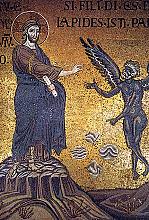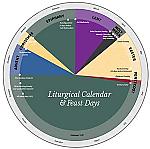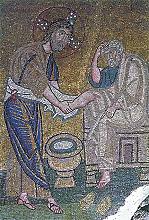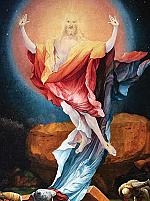Ash Wednesday
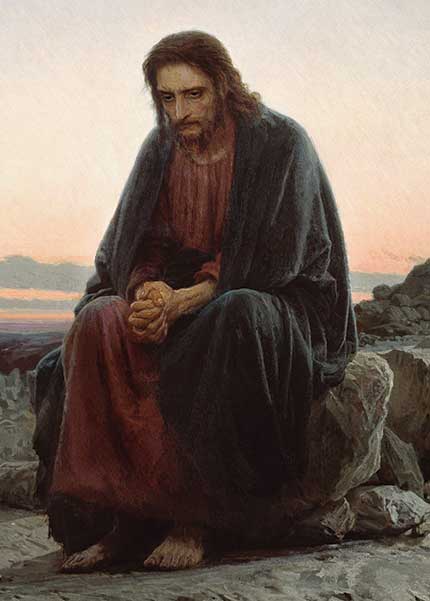
[ABOVE: Ivan Kramskoi, Christ in the Wilderness, 1872. Oil on canvas—Tretyakov Gallery / Public domain, Wikimedia]
From the feasting of Epiphany and the Sundays afterward, we move into the season of Lent. In the West this season begins on Ash Wednesday (46 days before Easter). In the East it begins on Clean Monday (48 days before Easter).
Where did it come from?
By now you’re familiar with the idea of liturgical observances developing backward; Easter came first and then came the idea of a period of fasting, penitence, and preparation before it; Lent itself is first referred to as a current practice in documents from the Council of Nicaea. Some Christians had continued the Jewish practice of imposing ashes as a general sign of repentance, and during the Middle Ages Western Christians began to do this at the start of Lent for those who had committed particularly grave sins. By the eleventh century, the Western church commended this practice for all believers. Eastern Christians do not celebrate Ash Wednesday; however, over time, the Eastern church has developed the idea of observing the first day (Clean Monday) and indeed the whole first week (Clean Week) of Lent as a special time of fasting and repentance.
How is the date determined?
Lent’s beginning depends on the date of Easter, which is decided in a complex fashion that we’ll discuss on page 33. Because Easter can occur on different dates in the Eastern and Western traditions, Ash Wednesday and Clean Monday usually do not occur in the same week, unless Eastern and Western Easters coincide; in years when they do, Clean Monday would be two days before Ash Wednesday.
Theological themes
In both East and West, believers are commanded to observe the beginning of Lent with repentance and prayer. The Western emphasis on ashes is coupled with a consideration of our own mortality and the fact that we will return to dust. In the East the day and week also strongly emphasize forgiveness and, frequently, actual spring cleaning.
Colors
In both East and West, the first day of Lent is no different from the rest of the season. In the West, this means the color is purple. In the East, purple is usually used on Lenten weekends and black on weekdays.
Customs
The primary Ash Wednesday custom in the West among Catholics and more liturgical Protestants is to attend church sometime during the day. There, a priest or minister imposes ashes, usually with the words “Remember that you are dust and to dust you shall return” or “Repent, and believe in the gospel” or similar phrases. Frequently one of the Scripture readings in the service will be all or part of Joel 2:1–17, which famously instructs:
“Even now,” declares the Lord,
“return to me with all your heart,
with fasting and weeping and
mourning.”. . .
Blow the trumpet in Zion,
declare a holy fast,
call a sacred assembly. (2:12, 15)
While originally the ashes were sometimes strewn on the head, today, almost universally, they are imposed in the form of a cross on the forehead. Many believers fast on this day, and if they have taken on some kind of Lenten observance (more on that in the next article) it begins on this day. Often, the ashes used come from the Palm Sunday palms of the previous year—saved, burned, and then blessed during the Ash Wednesday service. In the twenty-first century, a custom called “Ashes to Go” has developed where clergy go to a public place and offer ashes to passersby.
In the Eastern church, a special Vespers service called “Forgiveness Vespers” is held the evening before Clean Monday. During this service each member of the congregation, including the priest, asks forgiveness from each congregant, to which the other replies, “God forgives.” A midweek eucharistic service also takes place during Clean Week; this is the first of what are called the “Presanctified Liturgies” of the Lenten season.
These liturgies continue every Wednesday during Lent. Eastern Christians participate in a Lenten fast from all meat and dairy, as well as a stricter fast from Clean Monday through Clean Wednesday until they receive the Eucharist at the Presanctified Liturgy. The Eastern church encourages believers to go to confession during Clean Week. Also, at services during the week, portions of the “Great Canon of St. Andrew of Crete,” a famous prayer of penitence, are sung. Finally, Christians may use the week to clean their houses and donate to the poor. Among some churches it is common to spend much of Clean Monday outside. CH
Some ways you can participate
• Pray, fast if your health allows, and consider whether you will take on a Lenten observance.
• Do a spring cleaning.
• Donate time, money, or possessions to the poor.
• Attend a church service (outside the home).
By Jennifer Woodruff Tait
[Christian History originally published this article in Christian History Issue #156+ in 2025]
Jennifer Woodruff Tait is Senior Editor of CH magazineNext articles
Forty days in the desert
Lent is a time of preparation for the celebration of Jesus’s Resurrection and the Easter feast.
Jennifer Woodruff TaitThe holiest week of the year
The week between Palm Sunday and Easter has traditionally been considered the holiest week of the church year.
Jennifer Woodruff TaitCelebrating the risen Savior
Jesus’s Resurrection is the event on which everything else about the Christian faith depends.
Jennifer Woodruff TaitSupport us
Christian History Institute (CHI) is a non-profit Pennsylvania corporation founded in 1982. Your donations support the continuation of this ministry
Donate



